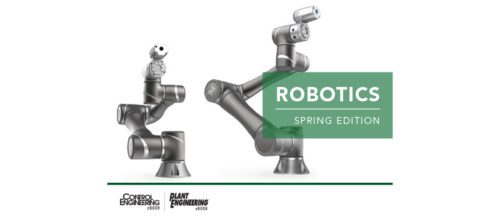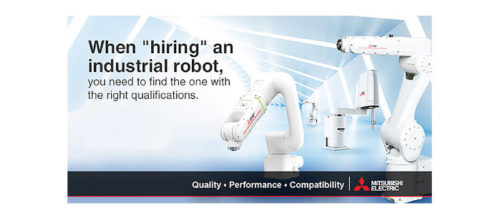The future of the industrial and collaborative robot markets for 2020 and beyond
The industrial and collaborative market has a bright future ahead as companies look to make robots faster, smarter and more efficient. See three market trends and two technology trends for the 2020s.
The recent “big picture” story with industrial robots has been a slowdown in the market driven by poor market performance in China, as well as slowing general investment in the two main end-user markets: automotive and 3C (computer, communication and consumer) electronics. An interesting sub-story has been collaborative robots, where we’ve seen continued strong performance – 30% revenue growth in 2019.
We are confident the overall industrial robots market slowdown is temporary and was driven by wider macroeconomics. The longer-term outlook for robotics is very positive due to a drive towards greater automation and an aging workforce in many countries.
The industrial robot market will start to pick up from 2020 with collaborative robots having an even better year. Looking further ahead, the big tech trends affecting the industrial robot market most significantly will be machine vision and machine learning as well as mobility.
Three future robot market trends
1. Industrial robots
In 2020 and 2021, we will see a rebound in the two biggest markets for traditional industrial robots: automotive and electronics, meaning there will be significant improvement in the industrial robot market. One thing driving long term growth is a trend for industrial robots to move into applications and markets they have not traditionally been used in. Another noticeable trend in industrial robots is toward smaller payload, entry-level, easy-to-use variants.
All this is driven by new technologies, by globally increasing labor costs and by competition from collaborative robots. Demand for these new “lighter” types of industrial robots is strongest from non-traditional markets such as logistics and food and beverage and, after 2021, a lot of the growth will be driven by these sectors. This was reinforced by a December 2019 visit to the IREX robotics show in Tokyo, where many robot vendors had dedicated logistics and food and beverage demos.
2. Collaborative robots
The collaborative robot market is pretty exciting right now. One of the most interesting things is rather than taking market share from traditional industrial robots, collaborative robots are helping expand the overall robot market’s boundaries. This means traditional industrial robot vendors can enter the collaborative robots market without too much worry about cannibalizing their own sales.
We are starting to see that with companies such as Fanuc and Yaskawa bringing new models of truly collaborative robots onto the market. Fanuc and Yaskawa have a more “industrial” take on the collaborative robot market, compared to the dedicated collaborative robot manufacturers who have dominated up until now. However, it seems likely they will ultimately find significant success with these offerings. The real competition in the collaborative robot market has only started; things are likely to get more competitive.
3. A regional view
Regionally, the collaborative robot and industrial robot markets have several clear trends. The EU (and Japan) have a strong emphasis on safety; China prioritizes low costs and ease of use; the U.S. is pushing boundaries by taking collaborative robots out of the traditional industrial space and into new markets, such as the service industry. This may be partly because manufacturing is a smaller sector of the economy in the U.S. than China and Japan, or in key EU countries such as Germany.
This means if robot companies want to sell their products, they have to look outside their core markets. It also may be down to culture: U.S. business culture is historically very open to risks, and to rapid innovation and change. Many of the new collaborative robot applications may fail, but it is possible U.S. customers may soon walk into burger bars and cafes staffed almost entirely by collaborative and industrial robots.
Two robot market technology trends
1. Machine vision and machine learning
Machine vision and machine learning are going to be among the most important technologies driving industrial and collaborative robot growth in the long term. One market being targeted by industrial robot and collaborative robot vendors is highly complex inspection, pick and place and sorting applications. Entry into these markets isn’t limited by the hardware – which is mostly advanced enough – but by software capabilities as applied to machine vision and machine learning. The implication is the robotics industry will come to be defined by its software.
These trends were obvious at IREX, and it was particularly interesting to see more dedicated machine vision and machine learning companies had their own stands at the show. The way forward for these specialist companies is partnering with big robotics vendors. To some extent, this is already a visible trend, but it is likely going to grow radically.
2. Mobility
In recent years, e-commerce logistics has rapidly adopted industrial robot technology. What is interesting is that, despite being a late adopter of robotics (compared to sectors such as automotive) e-commerce logistics companies have rapidly moved ahead in some areas, merging robots with mobility technology in a way that has never been done by manufacturers. In part, this is because of the industry: it is simpler to adapt robots for mobility in e-commerce applications than it is in manufacturing applications. Growth in mobile robots for manufacturing applications is set to accelerate and be one of the big trends in the 2020s as more manufacturers increase their automation investments.
At IREX, mobility demos were in almost every booth – with many specifically showcasing the possibilities of robot mobility for manufacturing applications. The technology is currently at the concept stage but it won’t be long before robots are moving up and down production lines and moving raw materials and finished goods around factory complexes.
Of course, this is not simple: it needs connectivity, Big Data and Internet of Things (IoT) technology to support it. In the end, it will be the big automation vendors who have the resources to integrate the systems and technologies into a coherent and viable market offering. As with machine vision and machine learning, many specialist, niche mobility companies will form deep partnerships with the industrial robot leaders to make this into a reality.
Jan Zhang, research director at Interact Analysis. Edited by Chris Vavra, associate editor, Control Engineering, cvavra@cfemedia.com.
MORE ANSWERS
Keywords: Industrial robots, collaborative robots, robotics
The industrial robot market will rebound in the 2020s and continue to grow.
The collaborative robot market is going to grow even more, and industrial robot companies will become more involved.
Major trends to watch are improved machine vision and machine learning and mobile robots.
Consider this
What do you think the biggest development will be in the robot market in the 2020s, and are you taking advantage?
Do you have experience and expertise with the topics mentioned in this content? You should consider contributing to our CFE Media editorial team and getting the recognition you and your company deserve. Click here to start this process.




